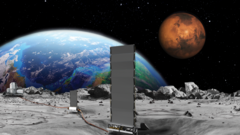As major space-faring nations rush to claim lunar territory, NASA has announced plans to establish a nuclear reactor on the Moon by 2030. The initiative aims to facilitate sustained human presence and power generation for future lunar activities, amidst concerns of geopolitical tensions as other countries, like China and Russia, also target the Moon for their endeavors.
Nasa Aims to Establish Lunar Nuclear Reactor by 2030 Amid International Space Race

Nasa Aims to Establish Lunar Nuclear Reactor by 2030 Amid International Space Race
The U.S. space agency is accelerating plans for a nuclear power source on the Moon to support human habitation and maintain competitive advantage.
NASA’s acting head has cited national security and the urgency of establishing a lunar economy as driving factors for this ambitious project. Despite recent budget cuts, officials have requested proposals from private companies to develop a relatively modest reactor capable of generating at least 100 kilowatts of power.
This projection, however, has drawn skepticism from scientists, with concerns about funding viability and safety of transporting radioactive materials into space. The initiative also raises questions about the implications of national sovereignty over lunar territories.
Building on prior contracts for nuclear reactor designs in 2022, experts believe it is feasible to launch this technology, though they emphasize the need for a robust infrastructure and further Artemis missions to make it a reality. As the international space race intensifies, some scientists fear that the focus may shift from scientific discovery to nationalistic posturing, potentially hindering collaboration necessary for deeper space exploration.
Given the Moon’s harsh day-night cycle, many experts argue that nuclear power may soon be indispensable for sustaining human life on its surface, marking a pivotal moment in lunar exploration and energy strategy.
While NASA’s plans expand, global discussions on ownership and operational space on the Moon grow increasingly relevant, making the establishment of space treaties and cooperation agreements ever more critical.
As nations like China and Russia assert their presence on lunar territory, discussions around safety zones raise complex questions about ownership and international cooperation in space exploration.
Nasa will have to overcome various hurdles, including operational logistics and public safety concerns, as it prepares to make strides toward establishing a permanent base on the Moon in the coming decade.
This projection, however, has drawn skepticism from scientists, with concerns about funding viability and safety of transporting radioactive materials into space. The initiative also raises questions about the implications of national sovereignty over lunar territories.
Building on prior contracts for nuclear reactor designs in 2022, experts believe it is feasible to launch this technology, though they emphasize the need for a robust infrastructure and further Artemis missions to make it a reality. As the international space race intensifies, some scientists fear that the focus may shift from scientific discovery to nationalistic posturing, potentially hindering collaboration necessary for deeper space exploration.
Given the Moon’s harsh day-night cycle, many experts argue that nuclear power may soon be indispensable for sustaining human life on its surface, marking a pivotal moment in lunar exploration and energy strategy.
While NASA’s plans expand, global discussions on ownership and operational space on the Moon grow increasingly relevant, making the establishment of space treaties and cooperation agreements ever more critical.
As nations like China and Russia assert their presence on lunar territory, discussions around safety zones raise complex questions about ownership and international cooperation in space exploration.
Nasa will have to overcome various hurdles, including operational logistics and public safety concerns, as it prepares to make strides toward establishing a permanent base on the Moon in the coming decade.


















